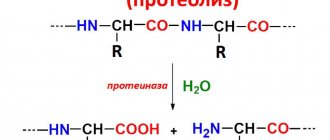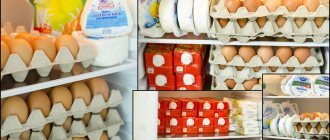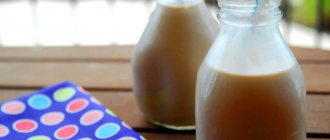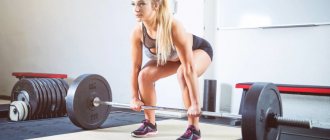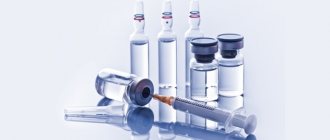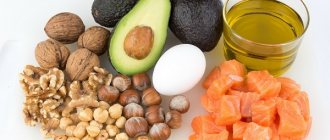Share:
In the new material we will touch upon the most important issue of modern athleticism, namely: is it possible to gain weight and cut at the same time? The opinions of endocrinologists, nutritionists and trainers differ in this regard. There are both successful examples of simultaneous cutting and gaining muscle mass, and unsuccessful ones. Let’s dig deeper to understand this topic in as much detail as possible.
Answer to the question
Before reading all the subsequent material, let’s give an immediate answer: simultaneous gain of muscle mass and cutting is, in principle, impossible for one simple reason: these are opposite processes.
Gaining muscle mass is an increase in anabolic levels, which stimulates super recovery in the body. While drying, especially the component that is responsible for fat burning, is an optimization catabolic process, in most cases it is forced for athletes.
BUT this does not mean that you cannot combine these processes. For all these tricks there is such a term as macro- and microperiodization.
Macroperiodization and microperiodization
It all depends on the construction of nutritional and training complexes. The usual cycle includes macroperiodization. What is its essence? It's quite simple - one step forward, one step back. Then two steps forward and one step back. First, we all gain muscle mass, and at the same time we gain glycogen reserves and, alas, body fat.
With proper training and nutrition planning, the set goes as follows:
- 200-300 g of muscle mass. The set depends on the level of metabolism and the level of the hormone testosterone - a direct stimulator of muscle protein synthesis.
- 500-1000 g of glycogen. Here everything is limited by the size of the glycogen depot. Thus, experienced athletes can gain up to 3 kg of glycogen per cycle.
- 1-3 liters of water. Since water is the main transport for all types of substances in our body, 3 liters of water per cycle is a systematic norm.
- 1-2 kg of adipose tissue.
Pure muscle mass accounts for about 10% of the total gain, or even less. Next, after several strength and mass-gaining cycles, athletes begin a drying period.
During the drying process (especially intensive), the following consumption occurs:
- 50-70 g muscle mass.
- 100-300 g of glycogen.
- 2-4 liters of water.
- 2-5 kg of adipose tissue.
Note: the so-called vacuum situations are considered above - i.e. with ideal adherence to the daily regimen, proper nutrition and training aimed at targeted fat burning.
After taking a few steps forward, the athlete takes a step back. In classic bodybuilding, periodization allows you to maintain the maximum amount of muscle mass, while losing as much body fat as possible. On average, using the classic system - 9 months of mass gain versus 3 months of cutting - the athlete receives a cumulative increase of up to 3 kg of pure muscle mass, and up to 20 kg of glycogen (it all depends solely on the characteristics of the body and the period).
Often the body fat becomes smaller than before the start of intense exercise.
With such periodization, simultaneous gain of muscle mass and drying is possible only during training, when the body intensively loses excess fluid, and super-recovery processes continue to stimulate the growth of protein tissue. However, the overall increase will be insignificant even when scaling this process for 1 month.
Conclusion: any classic athlete who does not use anabolic steroids will say that you cannot cut and gain muscle mass at the same time.
Now let's move on to microperiodization. This approach is used by athletes who engage in martial arts. After all, they need to constantly increase their speed and strength indicators, but at the same time maintain the same mass throughout the year.
The principles of microperiodization are almost identical to macroperiodization - only the period changes:
- Over the course of 3 weeks, you intensively gain muscle mass and glycogen reserves, trying to build metabolic processes in such a way that the overall increase in body fat is minimal.
- Then, in the 4th week, you begin a sharp transition to carbohydrate alternation or any other periodization diet. Being in its limit, you waste a huge amount of body fat.
- At the end of the month, you get the preservation of fat mass at the same level (a small gain or loss will be a statistical error), which is compensated by a gain of pure muscle mass.
Will such a result be noticeable in the short term? No! Will it be noticeable in the long term? Yes!
Whether this is considered simultaneous cutting and gaining muscle mass is another question. If we consider each period separately, then we cannot talk about simultaneous processes. But if we look at it in terms of macroperiodization, the answer is obvious... You have lost body fat and gained muscle mass.
Lane Norton on diet and nutrition while cutting
Principles of nutrition on a diet
Again, I repeat that it depends more on the person himself, his preferences and character. As for me, I prefer moderation in everything. My diet, like everyone else’s, includes proteins, fats and carbohydrates. I usually eat about 1-1.15 g of protein per body weight, fat makes up about 20-30% of the total amount of kcal, and the rest of my daily intake has to be supplemented with carbohydrates. In the off-season, this is about 240 g of protein, 80-90 g of fat and 450-500 g of carbohydrates.
A typical diet day out of season?
The macronutrients that I consume are always the same, but at the same time I try to diversify my menu as much as possible. To be honest, I don’t really believe in all this red tape around planned meals. Although most people simply go crazy about chicken and broccoli, considering them somehow “magical”. But the fact is that the body does not see the foods you eat; it divides everything into amino acids, carbohydrates, lipids and fiber. In other words, your body still gets amino acids from chicken breast or steak, as long as it gets the right amount.
Cutting diet plan
It depends on how my body reacts to what is happening and based on this I try to choose the most comfortable option for myself. I usually try to consume around 250-300g protein, 150-200g carbs and 45-60g fat per day. But on top of that, I always set aside two days a week when I gradually increase the amount of carbohydrates to 300-350 g, while reducing the percentage of protein and fat by 10 units.
Nutrition tips
Nutrition, like training, should be constant! I don’t believe in various kinds of dietary restrictions that make a person feel unhappy, but I also don’t believe in various cheat meals. Like I said, I believe in moderation and consistency! And speaking of moderation, read the book “The Hare and the Tortoise.” The turtle always wins!
Biochemical processes
Now let's talk about rationalizing microperiodization. Our metabolism is built on the principle of scales and strives for balance. Any impact on it, be it a change in the way we eat or a workout plan, is stress that our body resists.
When we influence the body, we strive to counteract the internal scales with external factors. This is how we gradually speed up our metabolism. Each time, more and more, we launch the principles of super-recovery and at the same time expand the glycogen depot. All this leads to a constant increase in strength indicators. Having reconfigured the scales, we practically do not encounter any counterweight from the body. This makes growth phenomenally fast.
This is especially noticeable in the first year of training, when a person, after the second month of training, begins a sharp increase in all indicators.
The same thing happens during drying - at first our body resists and strives to start optimization processes, but each time, succumbing to the trick, it burns fat and glycogen reserves faster and faster.
The body does not have time to get used to the current pace of exercise and diet. In fact, he does not know what will happen next - super recovery or extreme catabolism. Therefore, during microperiodization - after 2-3 months, progress stops completely. The body gets used to the type of load and to the periodization itself, maintaining the same balance. Consequently, the growth rate slows down.
Let's look at the numbers mentioned earlier
Using the classic system: 9 months of mass gain versus 3 months of cutting, the athlete receives a cumulative increase of up to 3 kg of pure muscle mass and up to 20 kg of glycogen.
In the case of microperiodization, an athlete, even if he follows all the basics in nutrition and training processes as competently as possible, will gain a maximum of kg of muscle mass and 5-6 kg of glycogen. Yes, it will be an immediate dry mass that will not require additional drying, but:
- Lean mass is highly influenced by diet. In case of violation of the regime, it is easy to lose the entire result for a month. At the same time, if there are large glycogen reserves and properly accelerated metabolism, losses in the event of a violation will amount to some crumbs.
- The cumulative increase is significantly lower.
- Microperiodization is much more difficult to maintain than macroperiodization.
- A complete stop of growth in all types of indicators is possible, which will entail adaptation. This is a strong psychological barrier. Any plateau is a powerful stress for an athlete and often leads him to think about quitting.
And most importantly: walking dry all the time is dangerous to your health. There are many examples of healthy and lean athletes simply dying due to the destabilization of all processes in the body.
Now, if you still haven't changed your mind, we'll look at how to effectively bulk and cut at the same time as part of microperiodization.
Diet planning
Let's look at the classic microperiodization system for simultaneous weight gain and fat burning:
| Phase | Phase time | Meal plan |
| Mass recruitment | 3 weeks | Moderate acceleration of metabolism - 4 meals a day. Calculation of the increase in calorie content is no more than 10% excess. The amount of protein per kg of net weight is about 2 g. Mostly slow carbohydrates. |
| Maintenance | 1 Week | Slowing metabolism - 2 meals a day. The increase in calorie content is 1-3% excess. The amount of protein is 0.5 g per kg of body. |
| Drying | 5-7 days | Moderate acceleration of metabolism - 6 meals a day. Calculation of calorie gain is no more than 20% of the deficit. The amount of protein per kg of net weight is about 4 g. Periodization within a weekly cycle is possible according to the principle of carbohydrate alternation. |
| Mass recruitment | 3 weeks | Moderate acceleration of metabolism - 4 meals a day. Calculation of the increase in calorie content is no more than 10% excess. The amount of protein per kg of net weight is about 2 g. Mostly slow carbohydrates. |
| Maintenance | 1 Week | Slowing metabolism - 2 meals a day. The increase in calorie content is 1-3% excess. The amount of protein is 0.5 g per kg of body. |
| Drying | 5-7 days | Moderate acceleration of metabolism - 6 meals a day. Calculation of calorie gain is no more than 20% of the deficit. The amount of protein per kg of net weight is about 4 g. Periodization within a weekly cycle is possible according to the principle of carbohydrate alternation. |
| Mass recruitment | 2 weeks | Moderate acceleration of metabolism - 4 meals a day. Calculation of the increase in calorie content is no more than 10% excess. The amount of protein per kg of net weight is about 2 g. Mostly slow carbohydrates. |
| Maintenance | 2 week | Slowing metabolism - 2 meals a day. The increase in calorie content is 1-3% excess. The amount of protein is 0.5 g per kg of weight. |
| Drying | 7-10 days | Moderate acceleration of metabolism - 6 meals a day. Calculation of calorie gain is no more than 20% of the deficit. The amount of protein per kg of net weight is about 4 g. Periodization within a weekly cycle is possible according to the principle of carbohydrate alternation. |
| Mass recruitment | 3 weeks | Moderate acceleration of metabolism - 4 meals a day. Calculation of the increase in calorie content is no more than 10% excess. The amount of protein per kg of net weight is about 2 g. Mostly slow carbohydrates. |
The cycle is designed for an ectomorph weighing from 70 kg with body fat up to 16%. It does not take into account the individual characteristics of training, nutrition, initial metabolic rate, testosterone levels, etc. At the same time, as an example of periodization within the framework of micro-changes in the cycle, it shows that you need to keep a food diary and clearly divide the diet into periods.
A maintenance period is needed so that, with accelerated metabolism after mass gain, you do not drain the muscles by switching to drying immediately. The optimal solution would be an additional supplement in the form of a maintenance cycle during the transition between drying and bulking. Yes, the effectiveness of such a diet will be minimal - the percentage of fat, as well as muscle mass, will increase slightly, in return you will get what you came for - a set of ideal lean muscle mass while simultaneously drying out the body.
We deliberately do not consider the issue of water consumption and consumption, as well as life hacks with the removal of excess salts, since we believe that in the long term this will cause more harm than good - especially for the heart muscle.
A competent strategy for changing mass collection-drying cycles
The traditional approach to gaining mass and working on relief is outdated, because few people want to do extra work, burning off layers of fat mass on the treadmill and hard-earned muscles due to the cortisol produced from a lack of calories.
Why not go the most competent and logical way - to ensure a smooth increase in lean muscle mass. This will not only allow you to look better during the mass-gain cycle, but will also significantly reduce the duration of the drying period.
Training planning
After drawing up a diet, proceed to microperiodization of training complexes. Here everything is somewhat more complicated: although training is less important than diet, without it mass gain, a determining factor in the process of microperiodization, is impossible.
| Phase | Phase time | Workout |
| Mass recruitment | 3 weeks | Heavy circuit training - working the entire body at least once a week. The remaining workouts should be a systematic split, loading the largest muscle groups. It is important to maintain high intensity with an overall short training complex. |
| Maintenance | 1 Week | Mostly split. To slow down metabolism as much as possible, it is recommended to temporarily abandon basic complexes. We work small muscle groups. We completely refuse cardio exercises, including warm-up ones. For warming up, it is better to use stretching complexes. This is the perfect time to work on your abs. |
| Drying | 5-7 days | Exclusively cardio exercise. The training cycle should be a two-day split, working half the body per workout with basic exercises in pumping mode for blood signature and glycogen reduction. Avoid any heavy exercise. After each basic exercise, perform 2-3 isolating exercises. The total training time, including cardio, should be about 120-150 minutes. It is recommended to use 4-6 workouts per week to achieve optimal levels of fat loss. |
| Mass recruitment | 3 weeks | Heavy circuit training - working the entire body at least once a week. The remaining workouts should be a systematic split, loading the largest muscle groups. It is important to maintain high intensity with an overall short training complex. |
| Maintenance | 1 Week | Mostly split. To slow down metabolism as much as possible, it is recommended to temporarily abandon basic complexes. We work small muscle groups. We completely refuse cardio exercises, including warm-up ones. For warming up, it is better to use stretching complexes. This is the perfect time to work on your abs. |
| Drying | 5-7 days | Exclusively cardio exercise. The training cycle should be a two-day split, working half the body per workout with basic exercises in pumping mode for blood signature and glycogen reduction. Avoid any heavy exercise. After each basic exercise, perform 2-3 isolating exercises. The total training time, including cardio, should be about 120-150 minutes. It is recommended to use 4-6 workouts per week to achieve optimal levels of fat loss. |
| Mass recruitment | 2 weeks | Heavy circuit training - working the entire body at least once a week. The remaining workouts should be a systematic split, loading the largest muscle groups. It is important to maintain high intensity with an overall short training complex. |
| Maintenance | 2 week | Mostly split. To slow down metabolism as much as possible, it is recommended to temporarily abandon basic complexes. We work small muscle groups. We completely refuse cardio exercises, including warm-up ones. For warming up, it is better to use stretching complexes. This is the perfect time to work on your abs. |
| Drying | 7-10 days | Exclusively cardio exercise. The training cycle should be a two-day split, working half the body per workout with basic exercises in pumping mode for blood signature and glycogen reduction. Avoid any heavy exercise. After each basic exercise, perform 2-3 isolating exercises. The total training time, including cardio, should be about 120-150 minutes. It is recommended to use 4-6 workouts per week to achieve optimal levels of fat loss. |
| Mass recruitment | 3 weeks | Heavy circuit training - working the entire body at least once a week. The remaining workouts should be a systematic split, loading the largest muscle groups. It is important to maintain high intensity with an overall short training complex. |
Working out during this period is characterized by the same serious changes in periodization as during nutrition.
We must not forget about such important aspects as:
- Constant shock to the muscles. Do not use the same training exercises when changing complexes. Example: if in the first cycle of mass gain you used deadlifts and squats with a barbell behind your back, then in the second cycle of mass gain use the Romanian deadlift with a trap bar, supplementing it with a squat with a barbell on the front.
- Do not use more than 50% of a single approach during drying periods.
- Don't do interval cardio - it can burn a lot of muscle if you can't keep track of your heart rate zone.
- During the support period, you can completely abandon basic exercises. Do not train more than 3 times a week; training time should be about 30 minutes.
Dickens Lambert on food for drying the body
What is more important for burning fat?
I believe that 80 percent of your appearance and your health depends on your diet.
How to eat before drying
I usually eat the same thing every day, but sometimes I can diversify my menu a little. I eat 6 times a day.
- Breakfast: oatmeal with protein
- Second and fourth meals: horse meat, sweet potatoes and any vegetables (raw)
- Third and fifth meals: chicken, basmati rice and vegetables
- Post-workout: Protein with orange or banana juice.
I also have a cheat meal once a week, usually on Saturday or Sunday, depending on my plans with family or friends
Cutting diet plan
The same as during the breaks... I try to achieve the shape I need, focusing on cardio exercises
Adviсe
Food is generally our fuel and our nourishment. Therefore, try to eat quality foods to feel good, both physically and mentally.
Philip Ricardo JR about the drying menu
What you need for a sculpted body
As for me, in order to achieve the desired shape, while losing as little muscle mass as possible, you need to watch your diet.
I used to start preparing for competitions 4-6 weeks in advance, but recently I decided to increase this period to 8-12 weeks. After all, the extra time allows me to get used to the new regime gradually (it’s very difficult for me to give up burgers and pizza so quickly) and maintain as much muscle as possible, while losing about a kilogram per week.
By the way, sometimes this weight loss can cause you to look less ripped during a photo shoot or competition. To avoid this, you need to try to consume the right amount of macroelements that the body needs so much, and then even after losing weight, you will look much better than you look during the breaks.
I usually support my body with diets that include high protein content. As for carbohydrates, the amount in my diet depends on my daily routine, for example, I have high carbohydrate days (200 grams), on such days I usually do cardio and strength training.
And on those days when I try to eat as few carbohydrates as possible (50 grams), I sit at home, watch TV or just read.
Like everyone else, I give myself a cheat meal, allowing myself to eat whatever I want. Also, once a week I allow myself to eat a delicious, juicy steak.
Oh yes, don’t forget about water, I try to drink about 5 liters of water a day.
Meals for the day during preparation and during the break
My menu during drying:
- 6:00 - oatmeal pancake (8 eggs, (1-2 yolks), half a cup of oatmeal)
- 8:30 – protein shake with water, amino acids and flaxseed oil
- 10:30 – can of tuna with mustard, brown rice and 5 grams of glutamine
- 13:00 (pre-workout) - protein shake with glutamine and vitamin (C/E)
- 16:00 – 2 chicken breasts and brown rice
- 19:00 - chicken breasts or fish, broccoli, green salad dressed with vinegar or olive oil
- 21:30 - steak and salad
- before bed - a protein shake
During breaks, I eat almost the same thing, but I just increase the percentage of carbohydrates.
Sportspit
As for sports nutrition supplements that are suitable for simultaneously gaining muscle mass and cutting within the limits of microperiodization, there are absolutely no secrets here.
- During the period of mass gain, use sports nutrition to gain mass.
- During the drying period, use sports nutrition for drying.
- During the maintenance period, use exclusively whey protein. A transition period is needed to remove excess creatine phosphate (in case you are overloaded with it) and prepare the body for a change in the course of drugs.
There are general recommendations that the editors recommend in case you decide to undertake such a serious experiment:
- Multivitamins - throughout the entire period. Don’t be afraid to get hypervitaminosis - during intensive drying, you will most likely reduce the amount of necessary micronutrients several times.
- BCAA - on an ongoing basis.
- Polymineral complexes. Look at the magnesium and zinc content that is most important in your case.
- Do not eliminate sodium completely during drying - leave a minimal amount for a more systematic entry and exit.
Effective fat reduction. Diet during drying
A diet for cutting (removing excess weight) is almost 70 percent of success, and no amount of hard training without a properly developed nutrition plan can bring the desired result.
You should definitely get rid of the idea that your previous diet will be suitable for the period of your training. This is not true at all. You will be forced to radically change your nutrition plan.
What is drying during bodybuilding?
Cutting is a competent workout together with a properly formulated diet, which is based on reducing the volume of subcutaneous fat while maintaining the muscle mass gained earlier.
The main points of the diet that you need to adhere to if you decide to go through the drying process while doing bodybuilding:
- The greater the amount of fat mass in your body, the greater the amount of protein you need to consume instead of carbohydrates. That is, if previously the ratio of proteins-fats-carbohydrates was approximately 20-20-60, now it is necessary that, on the contrary, it be 60-20-20. This means that approximately two-thirds of the carbohydrates consumed during the muscle building stage must be replaced using proteins. But in no case should you completely give up fats and carbohydrates, otherwise you can harm your own health. The proportion of protein should be increased compared to normal training periods and can be 3-4 grams per kilogram of body weight.
- Still, how many calories and carbohydrates should you add to your diet for cutting? The dosage of fat and carbohydrate intake should be selected individually, taking into account personal metabolic characteristics. This is quite easy to do - at a fairly slow pace and gradually reduce the amount of carbohydrates eaten during the day until the fat burning process itself is activated. This can be noticed with a decrease in body fat, as well as a decrease in body weight.
- The main amount of protein consumed during cutting should come from sports nutrition. What is the reason? The fact is that even products with a high protein content and low fat content, no matter whether it is fish, seafood or chicken, contain a large amount of saturated acids, which is completely unacceptable in today's situation. I would like to recommend stocking up on soy or whey protein. Protein is able to suppress catabolic processes and protect muscles without interfering with the drying process. You can find out what kind of protein you should choose and how to consume it on Vladimir Molodov’s website, from which you can download a free video course on sports nutrition. It is needed so that you can easily navigate the names of non-steroidal drugs and choose what you really need at this very moment, and not what the seller or fitness instructor recommends to you. I would like to recommend this site to everyone, as there is really high-quality information there.
- There should be absolutely no post-workout gainers, which many people mistakenly recommend. Only protein and carnitine. In one of the following articles we will discuss sports nutrition during weight loss in more detail.
- During the period of aerobic exercise, it is necessary to make it a rule to obtain carbohydrates only from products of natural origin, that is, from fruits or vegetables. No pies or buns! Try to forget about foods that kill your figure, at least for the duration of the diet.
- Try to eat foods that have a low glycemic index and slow carbohydrates. It is necessary to exclude “high-glycemic” and “simple” carbohydrates. A table of foods and their glycemic indexes is shown in the image below. The glycemic index indicates how quickly carbohydrates are digested, and the lower the index, the better it will be for you. Foods with a low glycemic index are broken down very slowly in the body and provide you with energy for a long period of time and are not stored as fat. Slow carbohydrates are found in cereals, wholemeal products, nuts, vegetables and unsweetened fruits.
- Try to eat more often, but in very small portions. This rule applies not only during weight loss, but also during muscle gain. In general, frequent eating can be called the basis of any bodybuilder's diet. Do not eat two hours before training and an hour and a half after.
- Any carbohydrates are prohibited 4 hours before bedtime. Taking carbohydrates at night, your body simply physically will not be able to process them during night sleep and they will be stored in reserve. At night, it would be best to drink a little protein shake with water or skim milk.
- The duration of the diet that is necessary when cutting is usually determined individually for each athlete, but usually it is 5-8 weeks. The essence of the diet is to gradually reduce the amount of carbohydrates every week. In the last week, carbohydrates are removed completely, and one carbohydrate-free week is established. Protein-containing foods need to be taken a lot and often. Only an exclusively “protein” diet can put additional stress on the kidneys. There is also a risk of ketosis (accumulation of ketone bodies in the blood) and even ketoacidosis (acidification, poisoning by ketone bodies), leading to drowsiness, weakness, dry lips, a feeling of acetone from the mouth, as well as other unpleasant effects. As a result, it is necessary to conclude that neither In no case should you abuse such a diet.
- Drying, as a rule, begins gradually; you cannot immediately give up carbohydrates and fats. A smooth, gradual reduction in the consumption of foods with carbohydrates will give you the opportunity to stay at a distance during the initial stage of the diet.
- On a diet during drying, water intake should in no case be limited. This is the most common mistake made by inexperienced people in this matter. Thanks to water, metabolism accelerates, and accordingly all processes, such as weight loss and weight gain, occur faster.
- We must not forget about the consumption of vitamin complexes, fiber and minerals during weight loss , because drying is a psychologically and physically difficult process and a deficiency of vitamins or minerals will only worsen your physical and psycho-emotional state.
- Eliminate all kinds of mayonnaise, ketchup, crackers and sauces from your diet. Also, during the drying period, alcohol is unacceptable, because it can irritate the mucous membrane, as a result of which you will overeat. Also, salted, smoked and canned food, even with the optimal composition of macroelements, should be excluded.
- A number of bodybuilders practice eating at night to suppress catabolism, which destroys muscle. You can wake up at night and drink a protein shake, thereby preventing muscle breakdown while you sleep. It is thanks to this lifestyle that you have the opportunity to demonstrate high-quality muscles and your flat stomach in competitions.
- If possible, you should avoid consuming dairy products with the exception of low-fat cottage cheese , because even low-fat dairy products contain a lot of carbohydrates, which help retain fluid in the muscles, which as a result will not allow the necessary muscle definition to develop.
It is recommended to include the following list of products in the cutting diet:
- Lean meat
- Fish
- Eggs
- Low-fat dairy products - cottage cheese, kefir, milk
- Porridge - millet, oatmeal, buckwheat, corn, etc.
- Legumes - peas, beans, beans
- Fruits and vegetables
Sample diet:
Description: This cutting diet lasts seven days.
. It lists only the main meals. It is recommended to have a snack between doses. Based on the above-described criteria for an optimal diet when cutting, it is possible to create your own nutrition program for the time of losing excess weight.
Monday
- For breakfast – oatmeal, sweet tea, protein shake;
- For lunch - chicken broth, chops with buckwheat, fresh vegetables;
- For dinner - fish fried in vegetable oil, fresh vegetables;
Tuesday
- For breakfast – buckwheat flakes, low-fat fish, tea with lemon and sugar;
- For lunch - chicken breast and vegetables, cauliflower soup;
- For dinner – low-fat cottage cheese with dried fruits and a protein shake;
Wednesday
- For breakfast – two boiled eggs, tea;
- For lunch - fish soup, fish, boiled with potatoes;
- For dinner, fruit with a protein shake
Thursday
- For breakfast – muesli with a protein shake;
- For lunch - mushroom soup, chicken breast, vegetable salad;
- For dinner - stewed fish and carrot and cabbage salad;
Friday
- For breakfast - an omelet of 2 eggs, a bun with honey and tea;
- For lunch - buckwheat soup, porridge with chicken fillet, fruit juice;
- For dinner: 2 apples, a protein shake;
Saturday
- For breakfast – semolina porridge with raisins, protein shake;
- For lunch - rice soup, peppers stuffed with cabbage, tea with lemon and sugar;
- For dinner – a couple of boiled eggs, a protein shake;
Sunday
- For breakfast – stewed fish, vegetable salad;
- For lunch - pickle soup, chicken breast and rice, fruit juice;
- For dinner – one apple with a protein shake.
In conclusion of this material, I would like to say again that high intensity training, the main goal of which is to reduce subcutaneous fat while maintaining muscle mass, does not mean anything without a diet composed competently and specially adapted for these purposes. If during the weight gain cycle the diet has almost equal importance with the training cycle, then during cutting, the nutrition plan comes to the fore and should account for at least 70 percent of successful weight loss.
Effective drying in 8 weeks. Detailed diet. Tables BJU + fiber
Igor May 18, 2013
Really effective remedy
Note: The following section is presented for informational purposes only. The editors are not responsible for possible damage to your body and do not advocate the use of AAS and other serious doping factors to achieve results.
Of course, in reality, everyone has been deceiving you all this time, including us! After all, a fitness instructor from a nearby gym goes dry all year round, while constantly building up a huge amount of muscle mass. He knows exactly the working method and is ready to advise you on a special product for a piece price. This drug is called anabolic steroids. Only with them you can simultaneously build muscle mass and dry out. And even with them, this process will not be particularly effective.
How does this happen? The thing is that if you choose the right course (from drugs that do not fill with water), you can increase protein synthesis even while drying.
The following medications and courses will help:
- Stanazol injection + Winstrol tablets. Both drugs have low conversion to estrogen and practically do not add water. They are often used during cutting to preserve muscle mass. But with constant use, they note that they have an anti-catabolic effect and have a slight fat-burning effect.
- Oxandrolone + testosterone propionate. The first is responsible for gaining lean mass, the second maintains the intensity of training during the cutting cycle.
Let us note right away: when working with hormonal drugs, completely different types of training complexes and diets are used. The principle of operation of these drugs is based on the fact that they force the body to synthesize protein (in the presence of building materials) even under conditions of external catabolic processes.
Extreme athletes can add growth hormone. It will cause hyperplasia, which in turn will increase the number of muscle fibers. This will in no way affect strength indicators, but will allow you to gain muscle mass even when following the most extreme and harmful mono-diets.
Important: If you decide to use AAS in your training, do not forget about the addictive effect, and most importantly, do not forget about the smooth entry and exit from the course with the advance use of post-course therapy drugs. Only in this case will you protect yourself from the appearance of gynecomastia, virilization or masculinization (for girls) .
To summarize
Now, knowing all the features of anabolic processes and exceptions, you know whether it is possible to gain weight and dry at the same time, or is this just a myth. Finally, I would like to say that if you use microperiodization, or get similar results at the start of your sports career, then it is better to still focus on one of the tasks.
So, when the body is fully tuned to catabolism or anabolism, it can accelerate this process, and, therefore, you will achieve the desired goal much faster than when using microperiodization.
It is much easier to spend 2 months on a periodized diet (carbohydrate cycling) and use a lot of cardio to get rid of excess fat, and then, with a lean body prepared for stress, radically change the nutrition plan to gain lean mass.
What about the girls?
Gaining muscle mass and cutting for girls is an issue that deserves special attention. The natural level of natural testosterone in women is several times lower. This means that microperiodization will not work at all. The maximum that can be earned in this case is problems with the endocrine system and metabolic disorders, which will then have to be treated separately.
It is better to use classical macroperiodization. If it is important for you to remain thin and slender throughout the year, use a cycle: a month of mass gain versus 3 months of low-intensity drying. Only in this case will you be able to maintain your “phytoshape” all year round, even without great achievements in sports.

